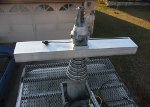|
I did a little more equipment testing today, this time across a 20.3 mile span. This was out in the desert, so there was very little interference from wifi, microwave ovens, etc. We started with a Hyperlink 19dbi grid antenna at each end. We were barely able to connect. It was pretty windy, which made it hard to keep them pointed precisely at each other. We then added a 500 mW amplifier at one end. That made the connection much more stable. Then we added a 1000 mW amplifier at the other end. That made the connection very reliable despite the antennas bouncing around a little in the wind. Bandwidth was good enough for video chatting.
I then replaced one of the grid antennas with a MFJ-1800 Yagi. The connection strength was noticeably less than with the grid antenna, but it was much more stable in the wind. I then tried replacing the MFJ-1800 with a $9 Chinese Yagi and we were barely able to connect.
So the lessons I took away from today's experiments were:
1. The grid dish antennas are hard to beat, but you've got to mount them in a way that stabilizes them in the wind.
2. You get what you pay for (i.e. the cheap Chinese antenna).
3. 500 or 1000 mW amplifiers can make a big difference.
We also made a solid connection between a grid dish and a 37" omnidirectional antenna across a 7.5 mile span. I was pleased to see an omni work at that distance. |
